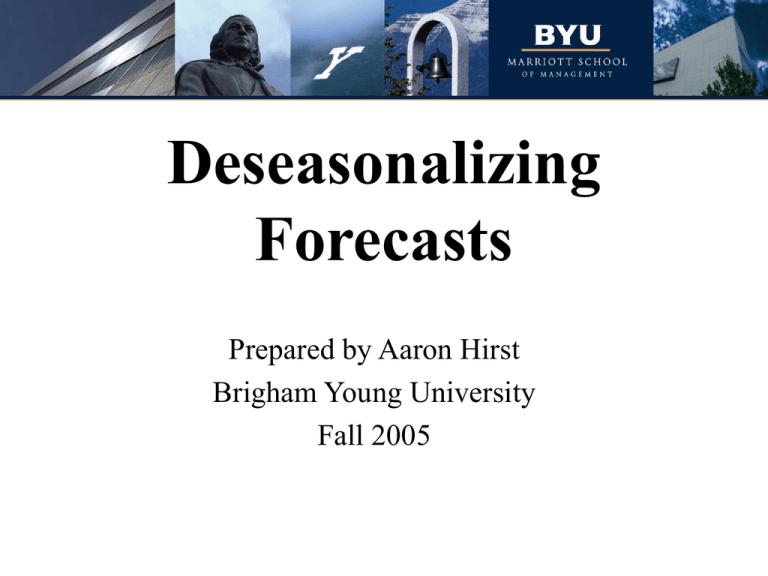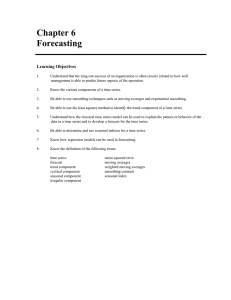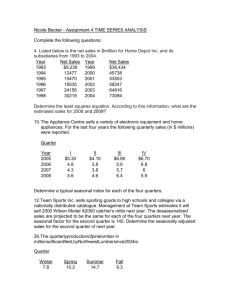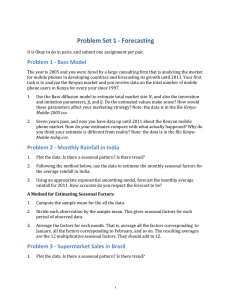deseasonalizing forecasts
advertisement

Deseasonalizing Forecasts Prepared by Aaron Hirst Brigham Young University Fall 2005 Agenda: • • • • • • • • • Seasonality defined & seasonal adjustment methods Brainstorming Exercise Nuts and Bolts How It Works Seasonal adjustment example Exercise Summary Reading List Appendix A: Solution to Exercise Seasonality • A repeated pattern of spikes or drops in the variable of interest associated with a period of time • Examples– Consumer buying habits – Price of gasoline Seasonality • Causes of seasonal movement by class: 1. Weather (temperature, precipitation) 2. Calendar Events (religious or secular festivals) 3. Timing decisions (vacations, accounting periods) Seasonal Adjustment Methods • • • • • • X-12 ARIMA X-11 ARIMA EEC Method Burman Method TRAMO Seasonal index Brainstorming Exercise • How can this tool be used in your organization? Nuts and Bolts Why make seasonal adjustments? – Reduces errors in time-series forecasting – Improves quality of judgmental forecasts – Gives good insight into the factors influencing demand The purpose of finding seasonal indexes is to remove the seasonal effects from the time series How It Works: Deseasonalizing Forecasts Four-step procedure for seasonal adjustments: 1. Calculate forecast for each demand values in the time series 2. For each demand value, calculate Demand/Forecast 3. Average the Demand/Forecast for months or quarters to get the seasonal index 4. Multiply the unadjusted forecast by the seasonal index to find adjusted forecast value Season Adjustment Example • Foster Company makes widgets. The quarterly demand for its widget is given in Exhibit 1 • Using linear regression forecasting, develop a seasonal index for each quarter and reforecast each quarter Exhibit 1 Year Quarter Demand 1 1 72 2 110 3 117 4 172 2 1 76 2 112 3 130 4 194 3 1 78 2 119 3 128 4 201 4 1 81 2 134 3 141 4 216 Seasonal Adjustments Example Step 1 Calculate forecast for each demand values in the time series – Use the unadjusted regression forecast model Y= a + bx Seasonal Adjustments Example – Step 1 Exhibit 2 • Forecasted demand Y=95.85+4.03*period • Year 1 Quarter 1: Y=95.85+4.03(1) =99.9 Unadjusted Regression Period Year Quarter Demand Forecast 1 1 1 72 99.9 2 2 110 103.9 3 3 117 107.9 4 4 172 112.0 5 2 1 76 116.0 6 2 112 120.0 7 3 130 124.1 8 4 194 128.1 9 3 1 78 132.1 10 2 119 136.2 11 3 128 140.2 12 4 201 144.2 13 4 1 81 148.2 14 2 134 152.3 15 3 141 156.3 16 4 216 160.3 Seasonal Adjustments Example – Step 2 Exhibit 3 • For each demand value, calculate Demand/Forecast • Year 1 Quarter 1: 72/99.9= 0.72 Unadjusted Regression Demand/ Period Year Quarter Demand Forecast Forecast 1 1 1 72 99.9 0.72 2 2 110 103.9 1.06 3 3 117 107.9 1.08 4 4 172 112.0 1.54 5 2 1 76 116.0 0.66 6 2 112 120.0 0.93 7 3 130 124.1 1.05 8 4 194 128.1 1.51 9 3 1 78 132.1 0.59 10 2 119 136.2 0.87 11 3 128 140.2 0.91 12 4 201 144.2 1.39 13 4 1 81 148.2 0.55 14 2 134 152.3 0.88 15 3 141 156.3 0.90 16 4 216 160.3 1.35 Seasonal Adjustments Example - Step 3 Exhibit 4 • Average the Demand/Forecast for the quarters to get the seasonal index • Quarterly Seasonal Index for Quarter 1: (0.72+0.66+0.59+0.55)/4 = 0.63 Quarterly Demand/ Seasonal Period Year Quarter Forecast Index 1 1 1 0.72 0.63 2 2 1.06 0.94 3 3 1.08 0.99 4 4 1.54 1.45 5 2 1 0.66 0.63 6 2 0.93 0.94 7 3 1.05 0.99 8 4 1.51 1.45 9 3 1 0.59 0.63 10 2 0.87 0.94 11 3 0.91 0.99 12 4 1.39 1.45 13 4 1 0.55 0.63 14 2 0.88 0.94 15 3 0.90 0.99 16 4 1.35 1.45 Seasonal Adjustments Example - Step 4 • Multiply the unadjusted forecast by the seasonal index to find the adjusted forecast values • Year 1 Quarter 1: 99.9 * 0.63 = 62.7 (adjusted forecast) Seasonal Adjustments Example - Step 4 Exhibit 5 Period Year Quarter Demand 1 1 1 72 2 2 110 3 3 117 4 4 172 5 2 1 76 6 2 112 7 3 130 8 4 194 9 3 1 78 10 2 119 11 3 128 12 4 201 13 4 1 81 14 2 134 15 3 141 16 4 216 Unadjusted Regression Demand/ Forecast Forecast 99.9 0.72 103.9 1.06 107.9 1.08 112.0 1.54 116.0 0.66 120.0 0.93 124.1 1.05 128.1 1.51 132.1 0.59 136.2 0.87 140.2 0.91 144.2 1.39 148.2 0.55 152.3 0.88 156.3 0.90 160.3 1.35 Quarterly Seasonal Index 0.63 0.94 0.99 1.45 0.63 0.94 0.99 1.45 0.63 0.94 0.99 1.45 0.63 0.94 0.99 1.45 Adjusted Regression Forecast 62.7 97.3 106.5 162.1 72.9 112.4 122.4 185.5 83.0 127.5 138.3 208.8 93.1 142.6 154.2 232.1 Seasonal Adjustments Example Seasonality Adjusted Forecast 250 250 200 200 150 Demand 100 Unadjusted Forecast Demand Demand Unadjusted Regression Forecast 150 Demand 50 50 0 0 1 3 5 7 9 11 13 15 Period Adjusted Forecast 100 1 3 5 7 9 Period 11 13 15 Exercise • Smith Company makes widgets. The quarterly demand for its widget is given in Exhibit A • You have been asked to develop a seasonal index for each quarter and reforecast each quarter Exhibit A Year Quarter Demand 1 1 20 2 9.2 3 33.2 4 40 2 1 33.2 2 24 3 46.8 4 53.2 Exercise Table Unadjusted Quarterly Adjusted Regression Demand/ Seasonal Regression Period Year Quarter Demand Forecast Forecast Index Forecast 1 1 1 20 16.4 1.22 1.09 17.8 2 2 9.2 21.0 0.44 0.52 11.0 3 3 33.2 25.6 1.30 1.18 30.2 4 4 40 30.2 1.33 1.21 36.5 5 2 1 33.2 34.8 0.95 1.09 37.8 6 2 24 39.4 0.61 0.52 20.6 7 3 46.8 44.0 1.06 1.18 51.9 8 4 53.2 48.6 1.10 1.21 58.8 Click here to check your answer Summary • Deseasonalizing forecasts is effective for – Short-term forecasting – Comparability – Detecting trend changes early • The Seasonal Index is the most simple method for making seasonal adjustments Reading List • Armstrong, J. Scott. Principles of Forecasting: A Handbook for Researchers and Practitioners. Norwell: Kluwer Academic Publishers, 2001. • Bozarth, Cecil C. and Robert B. Handfield. Introduction To Operations And Supply Chain Management. New Jersey: Prentice Hall, 2006. • DeLurgio, Stephen and Carl Bhame. Forecasting Systems For Operations Management. Homewood: Irwin, 1991. • Hylleberg, Svend. Modeling Seasonality. New York: Oxford Press, 1992. • Hylleberg, Svend. Seasonality in Regression. Orlando: Academic Press Inc., 1986. Appendix A: Solution to Exercise SUMMARY OUTPUT Regression Statistics Multiple R 0.779 R Square 0.607 Adjusted R Square 0.541 Standard Error 9.787 Observations 8 ANOVA df SS MS F 886.881 886.881 9.259 95.783 Regression 1 Residual 6 574.699 Total 7 1461.580 Coefficients Intercept X Variable 1 Standard Error t Stat P-value Significance F 0.023 Lower 95% Upper 95% Lower 95.0% Upper 95.0% 11.771 7.626 1.544 0.174 -6.888 30.431 -6.888 30.431 4.595 1.510 3.043 0.023 0.900 8.290 0.900 8.290 Appendix A: Solution to Exercise Unadjusted Quarterly Adjusted Regression Demand/ Seasonal Regression Period Year Quarter Demand Forecast Forecast Index Forecast 1 1 1 20 16.4 1.22 1.09 17.8 2 2 9.2 21.0 0.44 0.52 11.0 3 3 33.2 25.6 1.30 1.18 30.2 4 4 40 30.2 1.33 1.21 36.5 5 2 1 33.2 34.8 0.95 1.09 37.8 6 2 24 39.4 0.61 0.52 20.6 7 3 46.8 44.0 1.06 1.18 51.9 8 4 53.2 48.6 1.10 1.21 58.8





